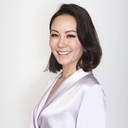Thank you for your question. You submitted a question with a single photo showing a close-up of your eyes, stating you have a fold in your right upper lid that is lower than the left upper eyelid. You noticed there is a relative fluctuation where there may be a crease at one point of the day, then it changes. Essentially, you are asking about symmetry and how to achieve it, or trying to create an appearance similar to your left eye which is more stable and constant.

